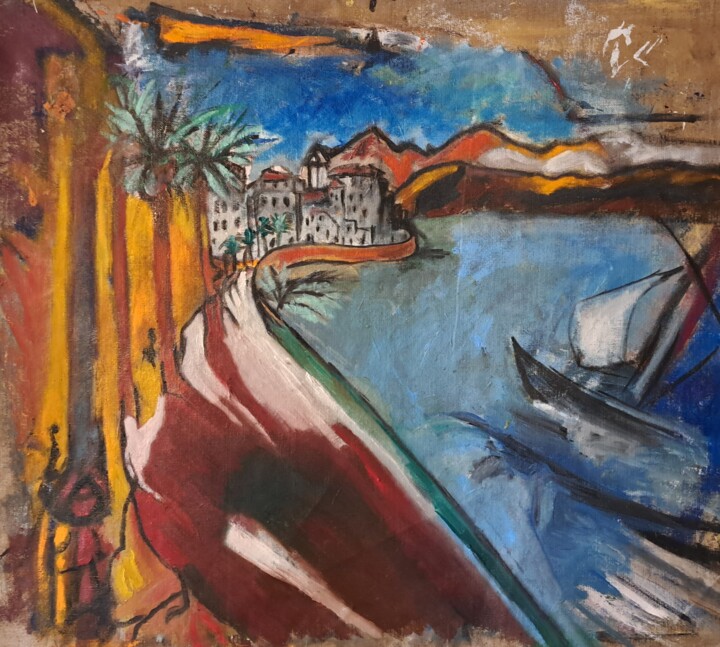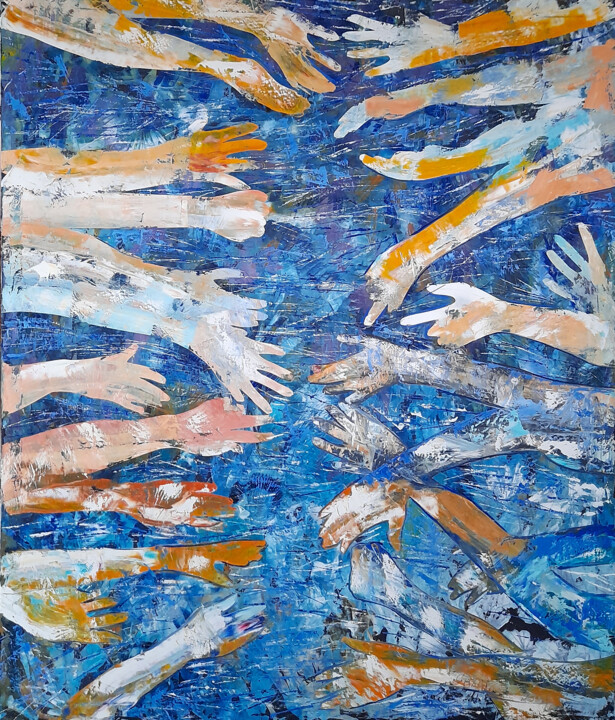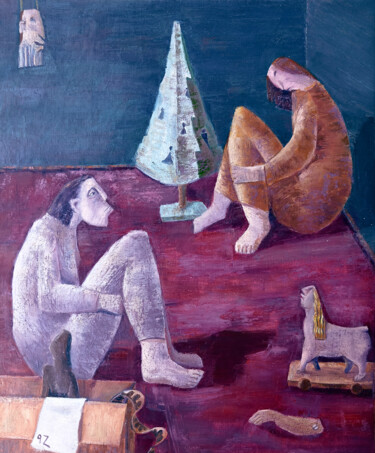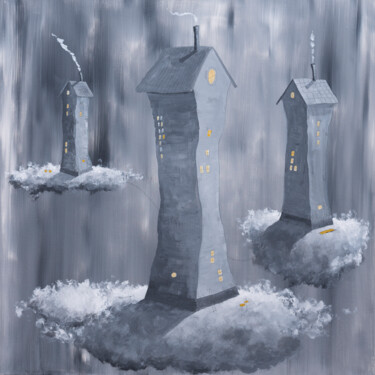18,623 オリジナルのアートワーク、限定版、版画:
{スタイル}スタイルを定義する方法は?
ナイーブアートとは?
ナイーブ アートとは何ですか? ナイーブ アートをどのように定義しますか?身廊絵画は、芸術についてあまり知らなかったアンリ・ルソーのような芸術家によって始められた芸術のスタイルです。ほとんどの場合、ネイブ アートは、プロのアーティストが行うトレーニングや教育を受けていない人が作成したビジュアル アートと定義されています。プロのアーティストがこのスタイルを真似ようとすることを「プリミティビズム」と呼びます。
Naive art の定義は?
ネイブアートは通常、プロのアーティストが行う正式なトレーニングや教育を受けていない人によって作成された視覚芸術と定義されています (解剖学、美術史、技術、遠近法、見方)。熟練した芸術家がこのスタイルを真似ようとすることを、プリミティビズム、疑似身廊、または偽身廊と呼ぶことがあります。
民俗芸術とは異なり、ネイブ アートは、特定の人気のある文化的背景や伝統に由来する必要はありません。実際、少なくとも先進国では、印刷革命以降、人気のある版画やその他のメディアを通じて広まった地元の美術の伝統について知らずにはいられません。素朴なアーティストは、グラフィカルな遠近法や構図の慣習などの「美術」の慣習について知っていますが、それらを最大限に活用することはできません。一方、アウトサイダー・アート(「アール・ブリュット」とも呼ばれる)は、同様の背景から生まれたが、主流のアート界とはほとんど関係のない作品を指します.
身廊は子供のように素朴で素直なことで知られ、真似されることも多い。この種の絵画は通常、フラットなスタイルの描画と、奥行きを示すシンプルな方法を備えています。アンリ・ルソーは、1844 年から 1910 年まで生き、パブロ・ピカソによって見出されたフランスの後期印象派であり、「ナイーブ アート」の最も重要な画家の 1 人でした。
この用語が何を意味し、民俗芸術や部外者の芸術などの他の用語と「終わる」場所については、いくつかの意見の相違がありました.ネイブ アートは通常、絵画や彫刻などの独学の芸術家によって作られた美術作品を表すために使用されます。一方、民芸品とは、日常生活で使用できるものを指します。しかし、この違いについては議論されてきました。 「Provincial」は、特に絵画や建物に使用できる別の言葉です。これは主に、伝統的な訓練を受けたアーティストの作品を表すために使用されますが、その作品は偶然に大都市や裁判所の基準に達していません.
ナイーブアートの特徴は?
ネイブ アートは、トレーニングや学位を持っていない (またはあまり受けていない) 部外者による作品と考えられることがよくあります。 20 世紀以前はそうでしたが、今ではナイーブ アートの学校があります。ナイーブ アートは現在、世界中のギャラリーで見ることができる完全に認知されたタイプのアートです。
ネイブ アートの特徴は、特に遠近法の 3 つのルールに従わない場合 (ルネッサンスのプログレッシブ ペインターによって説明されているように)、絵画の形式的な側面にうまく適合しません。
- 物は遠くに行くほど小さくなり、
- 遠ざかるにつれて色が変化する -遠ざかるにつれて細部が不鮮明になる
結果は次のとおりです。
- 遠近法の効果は幾何学的に間違っています (中世の子供の絵や絵のように見えますが、比較はここまでです)。
- 構図のすべてのプランでパターン、洗練されていない色を強く使用し、背景に弱体化はありません。 -影を落とす必要がある背景のものを含め、細部にも同様の注意を払います。
ナイーブアートは複雑ではないので見分けやすいと言われています。しかし、非常に人気があり、よく知られるようになったため、多くの例が「疑似ナイーブ」と呼ばれることがあります。
「疑似ネイブ」または「フェイクネイブ」アートは、より模倣的または自己意識的であり、その作品がオリジナルよりもコピーされているように見えるアーティストの作品です. 「身廊」アートは、アンリ・ルソーやアルフレッド・ウォリスのような美術学校やアカデミーに通っていないアーティストの作品です。
現代では独学が学習方法としてより一般的になっているため、現代のアーティストには厳格なナイーブは見られません。現存するアーティストは、単純な分類を常に好むわけではありませんが、より威厳のあるシグナルが知られるようになるにつれて、これは変わる可能性があります.現在、ハンガリーのケチケメートにはナイーブ アートの美術館があります。コバイカ、セルビア;リガ、ラトビア。ハエン、スペイン。ブラジル、リオデジャネイロ。フランス、ヴィック。そしてパリ。 Gary Bunt、Lyle Carbajal、Gabe Langholtz、Gigi Mills、Barbara Olsen、Paine Proffitt、Alain Thomas はすべて英語を話す生きたアーティストであり、素朴なスタイルを持っていることを認めています。
「プリミティブ アート」は、アートを学んだことのない人がアートを説明するためによく使うもう 1 つの用語です。しかし、歴史的には、西洋の学界が社会的または技術的に「原始的」と見なした文化の芸術を説明するために使用されてきました.ネイティブアメリカン、サハラ以南のアフリカ、太平洋諸島の芸術(部族芸術を参照).これは、「プリミティビズム」と呼ばれる「プリミティブ」に触発された自己認識運動とは異なります。フォークアートは、ネイブアートに似ていますが、同じものではありません。
また、「ナヴィズム」と「プリミティビズム」という用語もあり、これらは通常、ネイブ アートをスタイルとして使用するプロの画家 (ポール ゴーギャン、ミハイル ラリオノフ、パウル クレーなど) を表すために使用されます。
素朴な絵の特徴は?
ネイブアートは、専門的な訓練を受けていない、または学位を取得していない人々によって作成された芸術を説明するために使用されることがあります. 20世紀以前はそうでしたが、今では身廊絵画のアカデミーがあります。現在、ナイーブ アートは、世界中のギャラリーで見ることができる有名な芸術形式です。絵画の形式的な部分は、特に遠近法の 3 つのルールに従わないという点で、身廊を構成するものと奇妙に似ています。
・物は遠くに行くほど小さくなります。
・色から遠ざかるにつれて、鮮やかさが失われます。
-遠ざかるにつれて、詳細が不明確になります。
その結果の 1 つは、遠近法の効果が幾何学的な観点から間違っているということです。どの構図にも背景の弱まりはなく、パターンも多い。背景の暗い部分も含めて、すべてのディテールに同じ量の注意が払われました。
身廊は細かい部分が少ないのでわかりやすいと言われています。しかし、それは非常に有名なスタイルになっているため、多くの作品は疑似身廊またはプリミティビズムのカテゴリーに入れることができます.独学は学習方法としてますます人気が高まっているため、今日のアーティストには厳格な素朴さはあまり見られません。
現存するアーティストは単純な分類を常に受け入れるとは限りませんが、より威厳のあるシグナルが利用可能になるにつれて、これは変わる可能性があります.
Discover original contemporary Naive Art artworks on ArtMajeur
Original contemporary Naive Art is a type of artwork that features simple, childlike shapes, bold colors, and a lack of perspective. The main types of supports used in Naive Art are canvas, paper, and wood. The materials used to create these artworks can range from acrylic and oil paints to colored pencils and markers. What makes this type of original artwork unique is its ability to transport the viewer to a simpler time and evoke feelings of nostalgia and joy. Naive Art is often created by self-taught artists who have a raw, untrained talent that lends itself to a charming and endearing aesthetic. The result is a body of work that is refreshingly authentic and relatable.

©2025 Jihoon Kim
Origins and History
Naive Art, also known as Primitive Art or Folk Art, is a genre of art that emerged in the late 19th century. Naive Art pieces are characterized by their simplicity, childlike imagery, and lack of formal artistic training. The movement’s name comes from the French word "naïf," meaning "naive" or "innocent." The earliest examples of Naive Art can be traced back to the 17th century, with the works of French artist Henri Rousseau being some of the most well-known. The movement gained popularity in the early 20th century, with artists such as Grandma Moses and Horace Pippin gaining international recognition for their work. Naive Art has continued to evolve throughout the years, with contemporary artists putting their own unique spin on the style. Today, Naive Art continues to be celebrated for its childlike charm and whimsical imagery.

©2025 Michele Fabbricatore Galerie du Fauneによって表さアーティスト
Evolutions of theses works in the contemporary art market
Original contemporary Naive Art has undergone a significant transformation in recent years, reflecting the changing tastes of the art market. This style of art, known for its childlike simplicity and lack of formal training, has evolved to encompass a wider range of themes and techniques. Artists are now exploring more complex subject matter, such as social issues and political commentary, while also experimenting with new mediums and textures.

©2024 Barbara Versini
Related Famous Artists
Contemporary artists who are recognized for their exceptional work in contemporary Naive Art include:
Andre Bauchant, a French artist who gained recognition for his lively and colorful paintings of landscapes and still-life compositions. Bauchant’s works express a sense of simplicity and innocence, reflecting the spirit of Naive Art.
Séraphine Louis, a French painter known for her unique style of painting, which is characterized by its strong use of color and bold brushstrokes. Louis’s works are often inspired by religious themes and nature.
Henri Rousseau, a French post-impressionist painter who is recognized as one of the pioneers of Naive Art. Rousseau’s works are characterized by their flatness, bold color, and simplified forms, which reflect his lack of formal training.
Nikifor Krynicki, a Polish painter known for his depictions of life in the Polish countryside. Krynicki’s works are characterized by their vibrant colors, playful compositions, and a sense of childlike innocence.
Grandma Moses, an American folk artist who gained recognition for her paintings of rural life in the United States. Moses’s works are characterized by their simplicity, bright colors, and charming depictions of everyday life.
These artists have made significant contributions to the contemporary Naive Art movement, and their works continue to inspire and captivate audiences around the world.

©2024 Андрей Сахапов
Notable original contemporary Naive Art artworks
"La Danse" painted by Haitian artist Hector Hyppolite in 1946, depicts a colorful and whimsical scene of dancers in traditional Haitian dress. The painting is filled with vibrant hues and intricate patterns, capturing the energy and joy of the dance.
"Tree of Life" by Nigerian artist Prince Twins Seven-Seven, created in 1984, features a densely populated and intricately detailed tree with a multitude of human and animal figures interwoven with its branches. The piece is a celebration of life and the interconnectedness of all living things.
"Le Coq" by French artist Henri Rousseau, painted in 1899, portrays a proud and regal rooster surrounded by lush foliage and exotic animals. The painting’s bold colors and flattened perspective are hallmarks of Rousseau’s naively stylized approach to painting.
"Self-Portrait with Thorn Necklace and Hummingbird" by Mexican artist Frida Kahlo, completed in 1940, is a haunting and deeply personal depiction of the artist’s physical and emotional pain. The painting features Kahlo wearing a thorn necklace and a dead hummingbird, symbolizing her physical suffering and the loss of her fertility.
"La Reve" by French artist Séraphine Louis, painted in 1927, is a dreamlike and otherworldly depiction of a fantastical garden. The painting’s swirling colors and ethereal quality capture the sense of wonder and mystery that permeates Séraphine’s work.

Liana Asatryan
キャンバスのアクリル | 31.5x27.6 in

Bekir İSlam
紙のグラファイト | 7.5x5.9 in

Claudio Mario Andrea
キャンバスのアクリル | 76.8x60.2 in

Claudio Mario Andrea
キャンバスのアクリル | 59.1x59.1 in

Bekir İSlam
紙のグラファイト | 7.5x5.9 in

Claudio Mario Andrea
キャンバスのアクリル | 76.8x60.2 in
Rinetta Feliz
キャンバスのオイル | 31.5x23.6 in

Gegham Hunanyan
キャンバスのオイル | 23.6x19.7 in





























